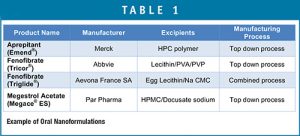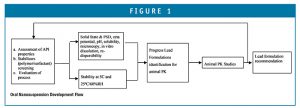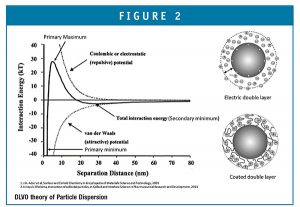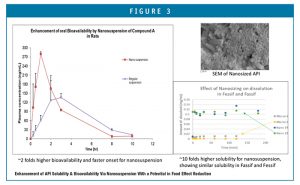Issue:June 2020
FORMULATION FORUM - Rational Design of Oral Nanosuspensions for Insoluble Drugs
A pharmaceutical nanosuspension is a fine dispersion of nanosized, insoluble API solid particles in a liquid medium. The particle diameter in a nanosuspension is usually less than 0.5 μm. Nanosuspensions are an important class of pharmaceutical dosage forms, particularly for pharmaceutical compounds with solubility and bioavailability challenges. Nanosizing is a widely used formulation method for sparingly soluble compounds as nanosuspensions offer an attractive option to enhance the rate of dissolution and solubility of poorly soluble drugs replaced by those compounds. The saturation solubility of the nanocrystals is highly related to the particle size, and solubility increases with particle size decrease due to the increased surface area, especially when the nanocrystals are below 300 nm. Consequently, the concentration gradient between gut lumen and blood is increased, resulting in improved absorption by passive diffusion. In these nanosuspension formulations, the rate-limiting step for drug absorption is normally the insoluble drug particle dissolution in the fluid surrounding the drug formulation.
The advantages of nanosuspension dosage forms include improving bioavailability, eliminating food effect, increasing drug loading, eliminating cosolvents, masking of bad API taste, improving API stability, dose reduction, better dose flexibility and accuracy, and easy swallowing for pediatric or geriatric populations. Examples for oral nano-dosage form are showed in Table 1.
FORMULATION DEVELOPMENT OF NANOSUSPENSIONS
Successful nanosuspension formulation development depends on careful evaluation of compound physical chemical and biopharmaceutical properties, such as solubility, pKa, solid surface properties, permeability, meting point, and crystal lattice structure. A good candidate for nanosuspension has the characteristics of BCS Class II compounds: low solubility, high melting point, high permeability, and a strong tendency of food effects. A formulation screening study is normally conducted under a small scale to find the suitable stabilizer(s), ie, a polymer, a surfactant, or a combination of polymer/surfactant for the nanosuspension. Different surface properties of API, such as surface charge, hydrophobicity, functional groups responsible for ionic, hydrogen bond, and Van der Waal interactions, may demand different types and level of stabilizers. The performance of nanosuspensions should be confirmed by in vitro studies, such as stability, re-dispersibility, and in vivo performance in animal models. Figure 1 is a high-level flow chart for nanosuspension prototype formulation development.
PROCESS FOR NANOSUSPENSIONS
Two commonly used methods for nanosuspensions include: “Bottom-up technology” and “Top-down technology.” Bottom-up technology is an assembling method to form nanoparticles by dissolving the API in a carrier, and then undergoing a process like precipitation or emulsification; whereas, Top-down technology involves the disintegration of larger particles into nanoparticles, examples of which are high-pressure homogenization, micro-fluidization, sonication, and wet milling methods, etc.
Wet Milling Technology
Wet milling (top-down process) is a relatively effective milling technique for nanocrystal preparation. The process is done in a media milling, and it treats a dispersion of concentrated drug in an aqueous or non-aqueous liquid medium with milling balls. It has several advantages in its economic value and ease in scaling up. With the right media milling equipment, manufacturers can cost-effectively create uniformly fine particles with limited or no contamination. However, due to the intensive mixing forces in the vessel, erosion of the milling balls is a common occurrence.
High-Pressure Homogenization Technology
High-pressure homogenization or microfluidization can also achieve suspension with narrow particle size distribution. It is a purely mechanical process, which is evoked by forcing a fluidic product through a narrow gap (the homogenizing nozzle) at high pressure. The liquid product is subjected to very high shear stress causing the formation of very fine particles. It can effectively process large volumes of liquid suspension sample thoroughly and reproducibly. Because it doesn’t use milling balls, contamination of the final product is much less; however, the high pressures applied cause a temperature increase because of the heat of compression, this needs to be controlled in case of heat-sensitive drug products. Alternatively, a combination of the bottom-up and top-down process, ie, solvent dissolution of API, crystallization by non-solvent, and then homogenization of freshly formed particles, could be utilized.
STABILITY OF NANOSUSPENSIONS
Nanosuspensions also possess some disadvantages relative to other dosage forms. The primary disadvantage is their physical instability, which can be overcome by thorough formulation design and development. According to the DLVO theory (Figure 2), the thermodynamic equilibrium state may be reached when the particles are in deep primary minimum, wherein attractive forces overpower the repulsive forces at short molecular distances less than 10 nm and the coagulation process is irreversible, leading to a breakdown of the suspension. However, if we design the nanosuspension formulation well so that when the primary maximum energy barrier is too high to overcome, the nanosupension particles may stay in the secondary minimum, wherein particles are held together by a weaker force than the primary minimum, and those loose aggregates can be re-dispersed. Utilization of particle charge, coating of the nanoparticles with polymer and surfactants, and selection of pH and buffer make it possible that the thickness of the electric and coated double layers of the nanoparticles could be expanded so that the total interaction energy between nanoparticles is located in the secondary minimum, and a stable nanosuspension is formed.
A CASE STUDY
A compound was classified as BCS II (low solubility and high permeability), which had a log P of ~4 and a meting point of ~130°C. Its aqueous solubility was extremely low, <0.2 μm/mL. The compound crystalline micronized suspension (mean particles size between 1-10 microns) had very low bioavailability in humans with a strong food effect. It was desirable to obtain a human formulation that had enhanced bioavailability and had no food effect. Based on the assessment of the compound properties, Ascendia’s Nanosol® Technology was utilized for nanosuspension formulation screening and in vitro assessment. Three nanosuspension prototype formulations were developed and tested for stability and animal PK studies. The lead prototype nanosuspension with a particle size below 200 nm resulted in a ~2-fold increase in bioavailability (Figure 3); and the nanosuspensions showed similar solubility in Fassif and Fessif and were stable for at least 3 months when stored at room temperature.
SUMMARY
Nanocrystal suspensions are a versatile and important class of pharmaceutical dosage form, particularly for pharmaceutical compounds with solubility and bioavailability challenges at the preclinical and early clinical development phase. The advantages of nanosuspension dosage forms include improving bioavailability, eliminating food effect, increasing drug loading, eliminating co-solvents, masking bad API taste, improving API stability, dose reduction, better dose flexibility and accuracy, and easy swallowing for pediatric or geriatric populations. It is critical to understand the colloidal properties of the API nanoparticles in order to formulate, process, and stabilize the nanosuspensions. In addition, the taste-masking, preservatives, sweeteners, and viscosity of nanosuspensions should also be considered for commercial product development.
To view this issue and all back issues online, please visit www.drug-dev.com.

Jim Huang, PhD
Founder & CEO
Ascendia Pharmaceuticals
j.huang@ascendiapharma.com
www.ascendiapharma.com
Total Page Views: 6650



















